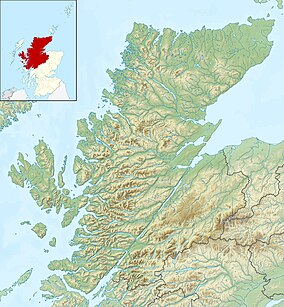Glenmore Forest Park
| Glenmore National Nature Reserve | |
|---|---|
IUCN category IV (habitat/species management area)[1] | |
 Glenmore Forest | |
| Location | Highland, Scotland |
| Coordinates | 57°10′12″N 3°42′58″W / 57.170°N 3.716°W |
| Area | 21.1 km2 (8.1 sq mi)[2] |
| Designation | NatureScot |
| Established | 2007[3] |
| Owner | Forestry and Land Scotland |
| Website | Glenmore Forest Park |
Glenmore Forest Park is a remnant of the
The Sportscotland National Centre Glenmore Lodge is situated about 1.5 km east of Loch Morlich, and is surrounded by the park.[10] During the Second World War the area was a training base for Norwegian resistance fighters, who are commemorated by a memorial located near to the visitor centre.[11]
Folklore
A fairy known as the
Flora and fauna
As a Caledonian Forest, the predominant tree species at Glenmore is
Glenmore Forest is important for many bird species, especially Scottish crossbill and capercaillie. In 2006 Glenmore was identified as having the highest productivity of capercaillie for any monitored site in Scotland.
Conservation
Extraction of timber from Glenmore dates back to at least the 17th century, with large scale extraction beginning in 1783. Felling continued into the 20th century, and the area was also used to graze sheep, and as a
In addition to its status as a national nature reserve and a forest park Glenmore is also designated as a Site of Special Scientific Interest (SSSI),[9] and forms part of the Cairngorms Special Protection Area (SPA). There are also two Special Areas of Conservation (SAC) that overlap with the NNR: the Cairngorms SAC and the River Spey SAC.[14] The NNR is classified as a Category IV protected area by the International Union for Conservation of Nature.[1]
See also
References
Citations
- ^ a b "Glenmore". Protected Planet. Retrieved 14 February 2021.
- ^ a b "Glenmore NNR". NatureScot. Retrieved 16 September 2020.
- ^ a b Glenmore Forest SSSI Site Management Statement. p. 6.
- ^ "Our Forest Parks". Forestry and Land Scotland. Retrieved 16 September 2020.
- ^ a b Glenmore Forest SSSI Site Management Statement. p. 5.
- ^ "National Forest Estate Forest Parks GB". Scottish Government Spatial Data Infrastructure. 21 September 2017. Retrieved 14 May 2018.
- ^ a b Glenmore Forest SSSI Site Management Statement. p. 1.
- ^ "Wildlife in Glenmore Forest Park". Forestry and Land Scotland. Retrieved 16 September 2020.
- ^ a b "Glenmore Forest SSSI". NatureScot. Retrieved 16 September 2020.
- ^ "Around us". Glenmore Lodge. Retrieved 24 October 2018.
- ^ "Glenmore Visitor Centre". Forestry and Land Scotland. Retrieved 16 September 2020.
- ^ Bane (2013), p. 252
- ISBN 9780114901752. Retrieved 19 June 2022.
- ^ a b c Glenmore Forest SSSI Site Management Statement. p. 2.
Bibliography
- Bane, Theresa (2013), Encyclopedia of Fairies in World Folklore and Mythology, McFarland, ISBN 978-1-4766-1242-3
- "Glenmore Forest SSSI Site Management Statement". Scottish Natural Heritage. 30 October 2008. Retrieved 11 February 2019.
External links
- Glenmore Forest Park - Forestry and Land Scotland
- Scotland's National Nature Reserves

